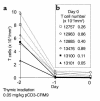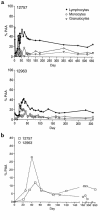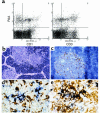Mixed chimerism and tolerance without whole body irradiation in a large animal model
- PMID: 10862793
- PMCID: PMC378506
- DOI: 10.1172/JCI8721
Mixed chimerism and tolerance without whole body irradiation in a large animal model
Abstract
Mixed hematopoietic chimerism may provide a treatment for patients with nonmalignant hematologic diseases, and may tolerize patients to organ allografts without requiring chronic immunosuppression. However, the toxicity of the usual conditioning regimens has limited the clinical applicability of this approach. These regimens generally include some level of whole body irradiation (WBI), which is thought to facilitate engraftment either by making room for donor hematopoietic stem cells or by providing sufficient host immunosuppression to enable donor cells to engraft. Here, we have established mixed chimerism across both minor and major histocompatibility barriers in swine, by using high doses of peripheral blood stem cells in the absence of WBI. After mixed chimerism was established, swine leukocyte antigen-matched (SLA-matched) donor skin grafts were tolerated and maintained for a prolonged period, whereas third-party SLA-matched skin was rejected promptly. Donor-matched kidney allografts were also accepted without additional immunosuppression. Because of its low toxicity, this approach has potential for a wide range of clinical applications. Our data may indicate that niches for engrafting stem cells are filled by mass action and that WBI, which serves to empty some of these niches, can be omitted if the donor inoculum is sufficiently large and if adequate host T-cell depletion is achieved before transplant.
Figures







Comment in
-
The future of allogeneic hematopoietic stem cell transplantation: minimizing pain, maximizing gain.J Clin Invest. 2000 Jun;105(12):1679-81. doi: 10.1172/JCI10375. J Clin Invest. 2000. PMID: 10862782 Free PMC article. No abstract available.
References
-
- Storb R, et al. Stable mixed hematopoietic chimerism in dog leukocyte antigen-identical littermate dogs given lymph node irradiation before and pharmacologic immunosuppression after marrow transplantation. Blood. 1999;94:1131–1136. - PubMed
-
- Walters MC, et al. Bone marrow transplantation for sickle cell disease. N Engl J Med. 1996;335:369–376. - PubMed
-
- Walters MC, et al. Barriers to bone marrow transplantation for sickle cell anemia. Biol Blood Marrow Transplant. 1996;2:100–104. - PubMed
-
- Storb R, et al. Current and future preparative regimens for bone marrow transplantation in thalassemia. Ann NY Acad Sci. 1998;850:276–287. - PubMed
Publication types
MeSH terms
Grants and funding
LinkOut - more resources
Full Text Sources
Other Literature Sources

